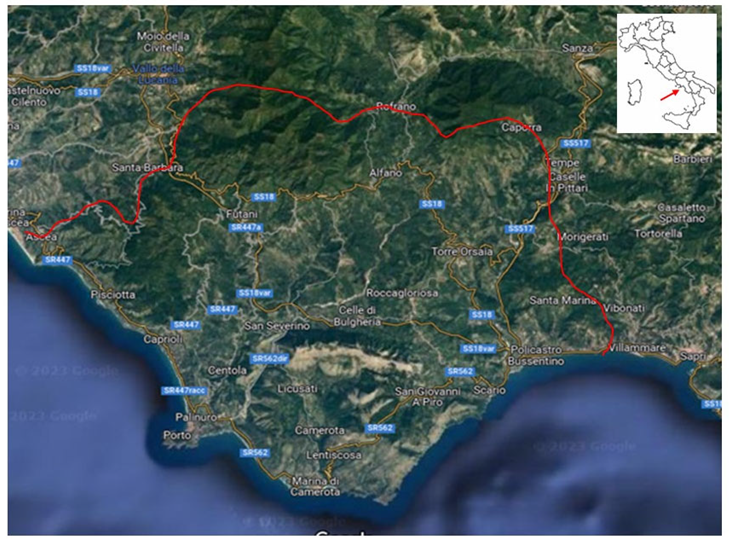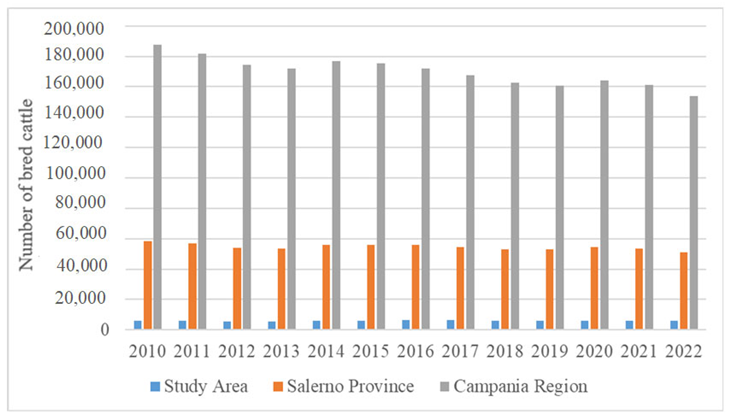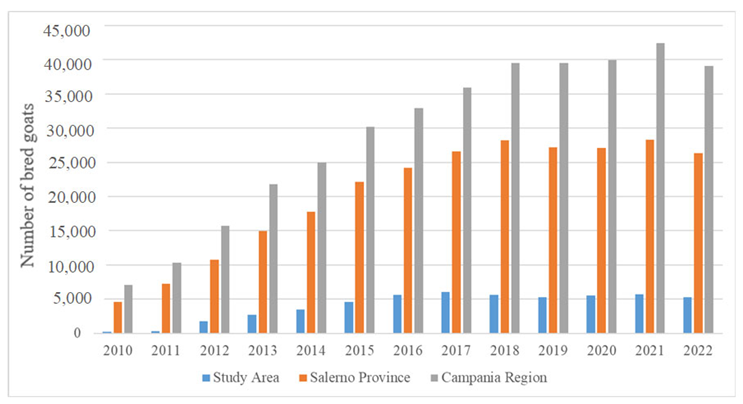Animal Husbandry in the Cilento, Vallo di Diano and Alburni National Park: An Economic-Structural Analysis for the Protection and Enhancement of the Territory and Local Resources
Abstract
1. Introduction
2. Materials and Methods
2.1. Study Area Description
2.2. Analysis of the Current Situation and Trends in the Study Area
2.3. Sample Sizing and Extraction
- 31 herds (about 50% of the population);
- 16 flocks (sheep and goat) (about 26% of the population);
- 15 animal farms (with cattle, sheep, and goat) (about 24% of the population).
2.4. Structure and Articulation of the Questionnaire Used
- 1.
- General overview: the questions about the ownership of the farm, the age of the interviewee, and the type of training were reported; as well as information regarding any farm and extra-farm activities of the owner, the registration with National Social Security Institute (NSSI) management, the presence or absence of other employees, full-time or part-time, and if there were other production processes in the farm connected to the livestock production.
- 2.
- Husbandry: questions were raised about the beginning of agricultural and breeding activity; the number of animals and species reared; the husbandry system and types of housing; the possible practice of transhumance; whether or not to register in the national livestock register (NLR). A particular role has been assigned to forage cultivation, and to this end, the following questions have been raised: forage production, purchase of forage, and feed and self-supply;
- 3.
- Farm structures: detection of the structural characteristics of the farm, and in particular the presence of farm buildings and surfaces.
- 4.
- Products and financing: value of products sold in the farm, forms of procurement of financial resources, land investments; business forecasts for the future and general concern about increases in production costs.
3. Results
3.1. The Livestock Sector and Its Recent Evolution in the Study Area between 2010 to 2022
3.1.1. The Cattle Sector
3.1.2. The Sheep Sector
3.1.3. The Goat Sector
3.2. The Results of the Sample Survey
3.2.1. Characteristics of the Entrepreneur
3.2.2. The Labor and Its Organization
3.2.3. Structure and Organization of Farms: The Characteristics of Husbandry
3.2.4. The Structure of the Farm
3.2.5. Productions and Future Prospects
4. Discussion
5. Conclusions
Supplementary Materials
Author Contributions
Funding
Institutional Review Board Statement
Informed Consent Statement
Data Availability Statement
Acknowledgments
Conflicts of Interest
References
- Cortignani, R.; Buttinelli, R.; Dono, G. Farm to Fork strategy and restrictions on the use of chemical inputs: Impacts on the various types of farming and territories of Italy. Sci. Total Environ. 2022, 810, 152259. [Google Scholar] [CrossRef] [PubMed]
- Farm to Fork e Biodiversità 2030. 2020. Available online: https://zootecnica.it/2020/05/26/farm-to-fork-e-biodiversita-2030/ (accessed on 3 January 2023).
- Feng, L.; Aryal, N.; Li, Y.; Horn, S.J.; Ward, A.J. Developing a biogas centralized circular bioeconomy using agricultural residues—Challenges and opportunities. Sci. Total Environ. 2023, 868, 161656. [Google Scholar] [CrossRef] [PubMed]
- Fortina, R. Razze e Parchi: La Zootecnia Nelle Aree Protette Italiane. Associazione RARE. 2019. Available online: https://www.associazionerare.it/razze-e-parchi-la-zootecnia-nelle-aree-protette-italiane/ (accessed on 10 December 2022).
- De Falco, E.; Rigano, D.; Fico, V.; Vitti, A.; Barile, G.; Pergola, M. Spontaneous Officinal Plants in the Cilento, Vallo di Diano and Alburni National Park: Tradition, Protection, Enhancement, and Recovery. Plants 2023, 12, 465. [Google Scholar] [CrossRef] [PubMed]
- Salvatore, D.; Cerrato, M. Fermo ma non inerte. Agricoltura e zootecnia del Cilento alla prova dell’intervento pubblico straordinario (1945–1992). Quad. dell’Archivio Stor. 2021, 1, 129–170. [Google Scholar]
- Gal Casacastra, Il Paesaggio Naturale. Available online: https://www.galcasacastra.it/territorio/ (accessed on 13 January 2023).
- L’importanza Della Zootecnia Nel Territorio Locale. Available online: https://nobilicilentani.com/2021/05/14/limportanza-della-zootecnia-nel-territorio-locale/ (accessed on 10 November 2022).
- NLR. Anagrafe Nazionale Zootecnica—Statistiche. Ministry of Health, 2022. Available online: https://www.vetinfo.it/j6_statistiche/#/ (accessed on 8 October 2022).
- Zheng, G.; Wang, Q.; Cai, C. Criterion to determine the minimum sample size for load spectrum measurement and statistical extrapolation. Measurement 2021, 178, 109387. [Google Scholar] [CrossRef]
- Arnab, R. Survey Sampling Theory and Applications, 1st ed.; Elsevier: Amsterdam, The Netherlands, 2017. [Google Scholar]
- Gregori, M. Introduzione All’economia ed Elementi di Economia Agraria; UTET Università: Torino, Italy, 2021. [Google Scholar]
- Passaro, A.R. Il Cilento Nell’inchiesta Agraria Jacini; Galzerano Editore: Casalvelino, Italy, 2005. [Google Scholar]
- Palladino, F. Aspetti e Problemi Dell’agricoltura Cilentana; Tip. del Senato: Rome, Italy, 1956. [Google Scholar]
- Cannata, G. Le Grandi Trasformazioni Economiche Dell’agricoltura Italiana Contemporanea, in AA.VV., Le Fonti Archivistiche Dell’agricoltura Italiana per la Ricerca Storico-Geografica; Accademia Nazionale delle Scienze Detta dei XL: Rome, Italy, 2019; pp. 13–29. [Google Scholar]
- Assessorato Agricoltura Regione Campania, 2021. Progetto AMiCA: Azioni a Sostegno delle Microfiliere Zootecniche per La valorizzazione delle Risorse Genetiche Campane Autoctone e delle Relative Produzioni. Available online: http://agricoltura.regione.campania.it/comunicati/comunicato_04-08-21B.html (accessed on 24 April 2023).
- Stampa, E.; Schipmann-Schwarze, C.; Hamm, U. Consumer perceptions, preferences, and behavior regarding pasture-raised livestock products: A review. Food Qual. Prefer. 2020, 82, 103872. [Google Scholar] [CrossRef]
- LAW 1 December 2015, n. 194, Disposizioni per la Tutela e la Valorizzazione Della Biodiversità di Interesse Agricolo e Alimentare. Available online: https://www.gazzettaufficiale.it/eli/id/2015/12/11/15G00210/sg#:~:text=LEGGE%201%20dicembre%202015%2C%20n.%20194%20Disposizioni%20per,11-12-2015%29%20note%3A%20Entrata%20in%20vigore%20del%20provvedimento%3A%2026%2F12%2F2015 (accessed on 24 April 2023).
- Regulation of the CAMPANIA Region 3 Luglio 2012, n. 6, Regolamento di Attuazione Dell’articolo 33 Della Legge Regionale 19 Gennaio 2007, n. 1 (Disposizioni per la Formazione del Bilancio Annuale e Pluriennale Della Regione Campania—Legge Finanziaria Regionale 2007), per la Salvaguardia Delle Risorse Genetiche Agrarie a Rischio di Estinzione. Available online: https://www.consiglioregionale.calabria.it/upload/istruttoria/7Reg%20REG.%20CAMPANIA%20N.%206-2012.pdf (accessed on 24 April 2023).
- Decree of the CAMPANIA Region, n. 87, 18/06/2018, Elenco Regionale Coltivatori Custodi—Sezione Animale: Approvazione Modello di Iscrizione e Avviso Pubblico (Con Allegati). Available online: http://agricoltura.regione.campania.it/biodiversita/doc/DRD_87-18-06-18.pdf (accessed on 24 April 2023).
- Wang, B.; Yan, H.; Zhang, Q. Reciprocity of grassland conservation and pastoralist livelihoods: Evidence from comparison between developed and developing regions. Ecol. Indic. 2022, 144, 109517. [Google Scholar] [CrossRef]
- Di Domenico, M.L.; Miller, G. Farming and tourism enterprise: Experiential authenticity in the diversification of independent small-scale family farming. Tour. Manag. 2012, 33, 285–294. [Google Scholar] [CrossRef]
- Razzaq, A.R.A.; Mohamad, N.H.; Kader, S.S.S.A.; Mustafad, M.Z.; Hadi, M.Y.A.; Hamzah, A.; Khalifah, Z. Developing Human Capital for Rural Community Tourism: Using Experiential Learning Approach. Procedia Soc. Behav. Sci. 2013, 93, 1835–1839. [Google Scholar] [CrossRef]
- Salvatore, R.; Chiodo, E.; Fantini, A. Tourism transition in peripheral rural areas: Theories, issues and strategies. Ann. Tour. Res. 2018, 68, 41–51. [Google Scholar] [CrossRef]
- Cucari, N.; Wankowicz, E.; De Falco, E.S. Rural tourism and Albergo Diffuso: A case study for sustainable land-use planning. Land Use Policy 2019, 82, 105–119. [Google Scholar] [CrossRef]
- Kastenholz, E.; Marques, C.P.; Carneiro, M.J. Place attachment through sensory-rich, emotion-generating place experiences in rural tourism. J. Dest. Mark. Manag. 2020, 17, 100455. [Google Scholar] [CrossRef]
- Sardaro, R.; La Sala, P.; De Pascale, G.; Faccilongo, N. The conservation of cultural heritage in rural areas: Stakeholder preferences regarding historical rural buildings in Apulia, southern Italy. Land Use Policy 2021, 109, 105662. [Google Scholar] [CrossRef]
- Teng, Y.M.; Wu, K.S.; Wang, W.C. Exploring rural winery loyalty: The effect of visitors’ experience in Taiwan rural winery tourism. J. Rural. Stud. 2022, 96, 32–41. [Google Scholar] [CrossRef]
- Chen, J.; Huang, Y.; Wu, E.Q.; Ip, R.; Wang, K. How does rural tourism experience affect green consumption in terms of memorable rural-based tourism experiences, connectedness to nature and environmental awareness? J. Hosp. Tour. Manag. 2023, 54, 166–177. [Google Scholar] [CrossRef]
- Mastronardi, L.; Giannelli, A.; Romagnoli, L. Detecting the land use of ancient transhumance routes (Tratturi) and their potential for Italian inner areas’ growth. Land Use Policy 2021, 109, 105695. [Google Scholar] [CrossRef]
- Ruiz, M.; Ruiz, J.P. Ecological history of transhumance in Spain. Biol. Conserv. 1986, 37, 73–86. [Google Scholar] [CrossRef]








| Farming Type | Only Restock | Only Meat | Mixed (Meat and Restock) | Mixed (Milk and Meat) | No Production | Total |
|---|---|---|---|---|---|---|
| Cattle | 3 | 4 | 13 | 4 | 24 | |
| Sheep and goats | 12 | 1 | 2 | 15 | ||
| Mixed (with cattle, sheep, and goats) | 2 | 9 | 2 | 13 |
Disclaimer/Publisher’s Note: The statements, opinions and data contained in all publications are solely those of the individual author(s) and contributor(s) and not of MDPI and/or the editor(s). MDPI and/or the editor(s) disclaim responsibility for any injury to people or property resulting from any ideas, methods, instructions or products referred to in the content. |
© 2023 by the authors. Licensee MDPI, Basel, Switzerland. This article is an open access article distributed under the terms and conditions of the Creative Commons Attribution (CC BY) license (https://creativecommons.org/licenses/by/4.0/).
Share and Cite
Cerrato, M.; Benincasa, G.; Iasi, A.; Pergola, M. Animal Husbandry in the Cilento, Vallo di Diano and Alburni National Park: An Economic-Structural Analysis for the Protection and Enhancement of the Territory and Local Resources. Sustainability 2023, 15, 7863. https://doi.org/10.3390/su15107863
Cerrato M, Benincasa G, Iasi A, Pergola M. Animal Husbandry in the Cilento, Vallo di Diano and Alburni National Park: An Economic-Structural Analysis for the Protection and Enhancement of the Territory and Local Resources. Sustainability. 2023; 15(10):7863. https://doi.org/10.3390/su15107863
Chicago/Turabian StyleCerrato, Michele, Giuliana Benincasa, Allegra Iasi, and Maria Pergola. 2023. "Animal Husbandry in the Cilento, Vallo di Diano and Alburni National Park: An Economic-Structural Analysis for the Protection and Enhancement of the Territory and Local Resources" Sustainability 15, no. 10: 7863. https://doi.org/10.3390/su15107863
APA StyleCerrato, M., Benincasa, G., Iasi, A., & Pergola, M. (2023). Animal Husbandry in the Cilento, Vallo di Diano and Alburni National Park: An Economic-Structural Analysis for the Protection and Enhancement of the Territory and Local Resources. Sustainability, 15(10), 7863. https://doi.org/10.3390/su15107863








